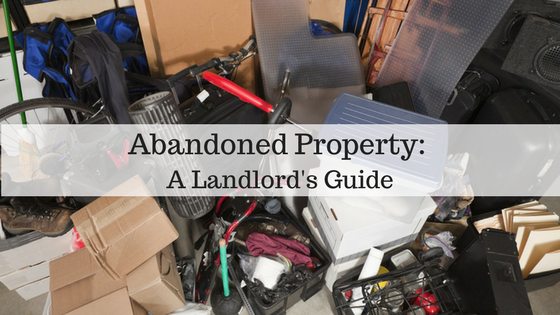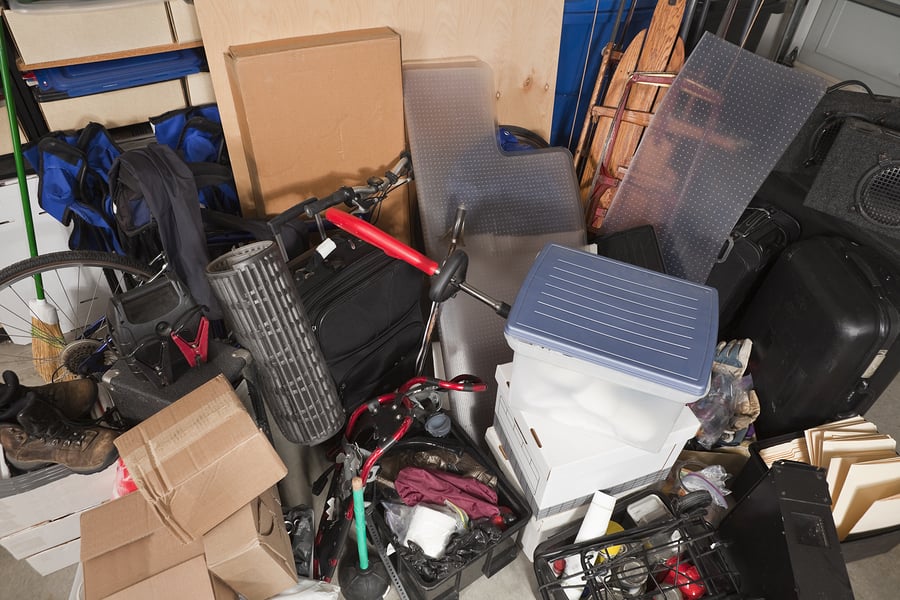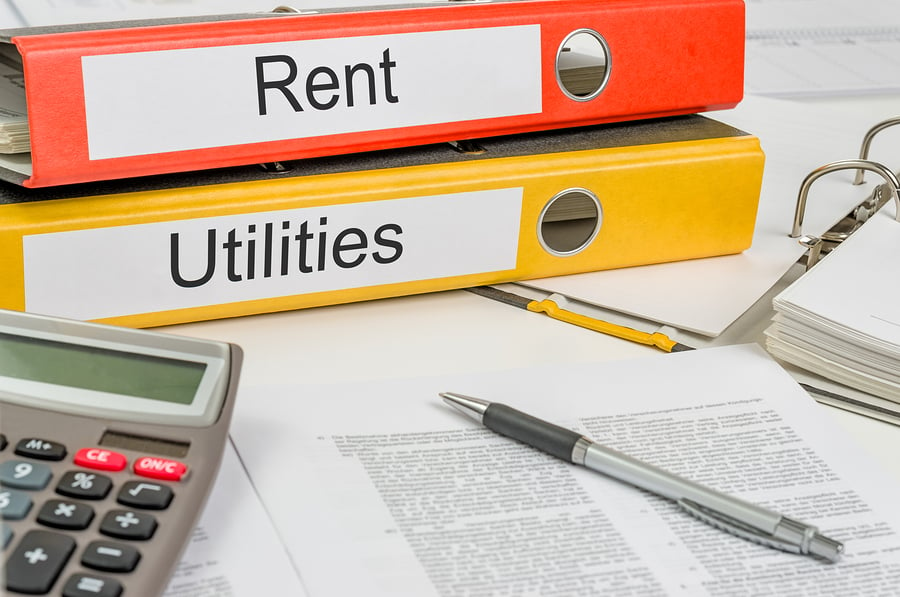
Tenant turnover is a time consuming, and often expensive, process for landlords. A move-out inspection will reveal the condition of your property upon vacancy, which every landlord hopes is the same as the start of tenancy. While every landlord will cringe at the amount of cleaning a rental unit may need, or any property damage the unit received during the lease term, another turnover situation one might encounter is tenant property that has been left behind.
Each state has different specifications about how a landlord or manager may handle tenant property that has been left behind in a rental unit upon vacancy. Below you will find a general guide about how to manage abandoned tenant property but you should always check with your state and local laws to find out what is required in your region for handling tenant property left at a vacated rental property.
What is tenant property?
Tenant property is considered any personal possessions or belongings owned by your tenant – this includes anything that was brought into the rental unit by your tenant or their guests including clothing, furniture, electronics, vehicles, etc. When a tenant moves out, they are required to also move out their personal property in order to restore the property back to the condition it was upon moving in. In some cases, tenants will fail to take all their items with them upon vacating the property, leaving the landlord to deal with the mess.
Although you might be tempted to sell, keep, or throw away everything your tenant left behind in your rental unit, there are certain procedures a landlord must follow in order to avoid liability claims or legal proceedings from the tenant.
Establish the reason for moving
Tenant property that is left behind at the end of a lease term is handled differently than tenant property that is left behind as the result of an eviction. A landlord can sometimes handle tenant property differently if he has written confirmation that the tenant will not be returning to the residence to finish a lease term or claim abandoned property.
The procedures described below represents what to do when a tenant voluntarily vacates a rental property either due to end of tenancy, or when a lease is broken early.
What to do with abandoned tenant property?
Before a landlord disposes of a tenant’s abandoned property, certain steps need to be taken to reduce the risk of liability for damages to the landlord. A landlord is responsible for taking certain steps to store a tenant’s property without damaging it and give the tenant a reasonable amount of time to reclaim their property.
- Itemize all Tenant Property– Create a list of all the items your tenant left behind at the vacated rental unit. It is a good idea to take a photo or video of each item to show its condition, to protect you from any damages claims.
- Safely Store the Property – You must store the tenant’s abandoned property in a safe place until the tenant removes them or the required time period passes. Types of storage facilities used by landlords in this situation include the rental unit or a commercial storage unit, sometimes the landlord’s own garage or property can be used to safely store abandoned tenant property.
- Notify the Tenant(s) – Write a notice to all the tenants who could claim ownership of the property, delivered in person or by first class mail with a return receipt, that includes:
- The itemized list of property left at the rental unit, descriptive enough for your tenants to identify them.
- The deadline for claiming the property – timelines for claiming property are state specific and range from 5 – 45 days depending on the value of the items.
- Where the property is being stored
- The charge for storing the tenant’s property
- Information on what the landlord will do with the property if it is not claimed within the allotted timeline.
The process described above relates to abandoned tenant property Your state may have alternative requirements for how to handle apparently lost property, or property whose legal owner is unknown.
What happens when the tenant wants to claim the property?
If the tenant responds to your notice in an attempt to reclaim the abandoned property within the timeline, you must act in good faith to make the belongings available to the tenant at a reasonable time and place.
In most cases, a landlord may charge the tenant the costs associated with removing and storing the tenant’s property, as long as the price is reasonable and reflects fair market value.
What happens if the tenant does not respond or attempt to claim the property?
If the tenant does not claim the property or contact you to collect it, most states allow a landlord to sell the abandoned property at a public or private sale. A landlord can usually keep the reasonable cost for notice, storage, and sale from the proceeds of the sale. The remaining balance is then forwarded to the tenant or paid to the county, depending on your state’s rules.
If the value of the items is under a certain amount a landlord may simply throw away or give away the belongings; this amount set by your state’s landlord-tenant laws.
Exceptions to landlord storage requirements:
A landlord may immediately dispose of rotting food that once belonged to the tenant. And a landlord may allow an animal control agency or humane society to remove abandoned pets or animals. Special rules also apply to motor vehicles. Be sure to check with your state’s regulations on these types of abandoned property requirements.
Another exception related to managing tenant property pertains to property fixtures. If a tenant installed items attached to the walls or ceilings, like shelves, fans, bars or lighting, and leaves them behind, the fixtures become the landlord’s property. If the landlord does not want the fixtures, they may have the right to charge the tenant for removing and restoring the property to its condition prior to tenancy.
What if a landlord doesn’t follow the requirements for abandoned tenant property?
If a landlord fails to notify the tenant of the right to recover abandoned property or refuses to turn over the tenant’s belongings, the tenant has rights to file an action against the landlord.
What can a landlord do to avoid dealing with abandoned tenant property?
When a tenant vacates a rental unit, the last thing a landlord has time to do is go through the abandoned tenant property procedures described above. Collecting, itemizing, storing, notifying, and arranging to sell or dispose of the tenant’s property takes up a lot of time and energy for the landlord. The best way to avoid this situation is to screen potential tenants in order to find ones who have proven themselves to be responsible people and renters. Tenant screening should always include a background check to reveal financial responsibility and law-abiding behavior. Screening should also include a call to previous landlords who will have information about the condition an applicant left his previous rental unit upon vacating. If the previous landlord mentions abandoned property, that should be a red flag.
Landlords Need a Great Lease
A good lease agreement will have specific language about what is required of the tenant in terms of maintaining the rental property and returning it in the same condition it was received at the start of the lease term. You should always do a walk through and move-in inspection with your tenant at the start of tenancy so you are both on the same page about the condition at the time of occupancy and what you expect it look like when they move out. This includes removing any personal property.
Your lease should also include language about what you will do with any tenant property that is left at the rental property at the end of the lease term. When reviewing this section of the lease agreement with your new tenant, make sure they understand the charges they may incur related to removal and storage of any abandoned property. Providing a clear description of what happens to left behind tenant property in your lease gives you further legal ground should a tenant challenge you about removing or disposing of their abandoned personal property after the proper steps were taken.
Have you ever had to deal with abandoned tenant property at any of your rentals? What processes did you have to go through to manage the situation?
*This article is intended to provide general information about managing tenant property left at a vacated rental property, it should not be taken as legal advice. You should always consult a lawyer that is familiar with landlord-tenant laws in your state to find specific requirements you need to follow regarding tenant property.







A tenant abandoned a w/d unit. It’s been over 30 days. Turns out the tenant was renting it from a rental store. The rental store now wants to claim the unit. Is there any way to charge the rental store for storing the unit? State of FL.
That is an excellent question. I would think that you would charge the tenant for storing the property still, but I am not sure.
What should I do my landlord refused to let me get my belongings out of the house after they changed the locks. And I think that they did a self eviction on us.we really didn’t do anything to them but I want all of my belongings back. I feel that we were wronged.
Hi Tina, There are specific rules your landlord should follow regarding your belongings–this process could vary depending on your state or local laws. I would contact your local fair housing authority to find out what steps you can take in this circumstance.
What happens when someone dies in an apartment (complex) and the NOK abandons the property and the deceased?
What about when a Landlord has left items on the property that you are renting. When my boyfriend moved into a rental, there were many items left behind that the landlord said he would remove. This never happened after 2 years of living there. The lease agreement did not have details about throwing away items left behind or selling them or not using his shed. Now, after one item was sold out of the shed, the landlord is pressing criminal charges on him.
Interesting question, Klarisa.
Rental agreements (leases) are designed to help avoid these types of scenarios. Tenants have the right to review a lease and suggest addendums and conditions prior to signing. They also have the right to request an addendum be added at any time during the lease – the landlord, of course, has the ultimate right to accept or deny that request.
As that didn’t occur, at minimum, it is always best to have the approval of the landlord in writing before using, removing, or selling any item that does not belong to the renter.
Your boyfriend may want to seek legal counsel and/or reach out to the landlord regarding arbitration to settle this peacefully. I would also contend that the money from the sale of the item ultimately belongs to the landlord – giving those funds to the landlord with an apology may go a long way towards reconciliation.
My tenant passed away in his apartment and was not found for 9 days. So you can imagine what goes along with that. The Coroner gave the family my phone number. They are out of state and do not want anything except papers and his laptop. Where can I get a form for release of property? I don’t want any issues in the future because I didn’t do my do diligent s. My insurance will take care of cleaning and replacing flooring but I don’t want to proceed without some release. I think the tenant had some funds but how do I attach them to cover my $5000 deductible. I only have a $700 deposit. This is in California. Do I need an attorney?
Thank you
Diane
Diane, You are wise to seek out advice on this matter. I am not qualified to offer legal advice but do know that California has very specific rules about how to handle terminating the lease, working with the executor for reimbursement, and dealing with the abandoned personal effects of a deceased renter. Because of the complexity of the situation and ramifications if handled incorrectly, I would highly recommend reaching out to an attorney versed in California real estate law to make sure you follow all the regulations regarding the personal property and release. Wishing you a speedy resolution.
During this pandemic, a tenant was rerouted from a traditional hospital visit to a convalescence home, then back home, then back in the hospital. The man is 86 years old, in poor health, family has never been in the picture and doesn’t respond to phone calls (Phone numbers found on online Search), wife divorced and left him 7 years ago. She refuses to discuss his late rent (2 months), or connect me w/ family. Basically he’s been abandoned. Prior to Covid, it’s been years of games, hardships getting rent, he flooded the unit – too old to bend down and turn water off behind toilet. Need help with his wellbeing, back rent paid, maybe hospice care for him. He’s a retired vet! Zero people involved in his wellbeing. If he does come home, I won’t even know he’s there.
What can I do. He’s lived there 27 years and his rent is about $1,500 less than the going rate.
1. His safety
2. Rent updated
3. Tenant relocated
Oh no! My heart goes to your tenant and to you for dealing with this difficult situation.
I can hear the concern you have for his safety and are correct that this is the first priority. If he is unwilling to help you contact his family then it may be a choice he is making not to get the help he needs. There are two agencies that might be able to help you.
Adult Protective Services will be able to assess his ability to live independently and have resources to find solutions for his unique situation. And, whether he wants help from his family or not, in many states if the family has abandoned him it could be considered elderly abuse or neglect. In that, you may also want to contact your local Elderly Abuse Agency as well. They may have suggestions on how to locate his family and advocate for a safer living environment.
I wish you both all the best during this difficult time.
If a tenant dies, is it considered an eviction abandonment? My aunt died in another state (Idaho) and none of us have the financial means to collect her property. Her children want nothing to do with this, leaving the burden on my father (her brother) and I. The landlord called saying she plans on throwing everything out so she can rent the unit.
I can’t get a straight answer out of any website about what the landlord has to do with her property in the meantime. Any ideas?
Amanda, I’m sorry to hear about your aunt. It is difficult to find information online because this becomes a legal issue and is regulated at the state and local level so there are many different ways abandoned property gets handled across the country. Some states allow a landlord to store the items so they can clean and rent out the unit. Other states require the landlord to wait for an executor to make those decisions and have those items moved, etc. So, the best suggestion I have is to reach out to the housing authority in the city or county your aunt lived. They will know the state and local regulations that the landlord must follow for abandonment. I wish your entire family comfort during this time.
Our tenant has no known next of kin and no executor or will. He has a retired nurse who cared for him and is helping with medical decisions. He had a stroke and is now in a vegetative state. Medical ethics board is choosing to remove respirator. If he lives he goes to a critical care facility for palliative care until death. If he dies…well we have clue what to do either way. He is 4 months behind on rent. We have cleaned out the food and donated it, the nurse took the cat. This is in Virginia. What happens next? If he lives how can we evict with the moratorium in place? Do we file as abandoned property?
I did a little digging and found an overview here: Handling Tenant’s Abandoned Property in Virginia
and the Virginia statute on disposal of property abandoned by tenants and writs on judgements for specific property
With the eviction moratorium and the complexity of this situation you may want to reach out to the Virginia Real Estate Board or Local Housing Authority as well as an attorney familiar with real estate law to get clarity before making any decisions. Hope this information helps while you work through this difficult scenario.
Thank you so much! At least now I have a starting point! We just had to clue where to even start researching. I appreciate your help!!!
Absolutely my pleasure, Melissa. Having been in your shoes, although I no longer manage properties, I’m always happy to help landlord’s in the trenches.
My mother in law was leasing this apartment the is income based and she was in a bad ATV accident and was hospitalized she had to go to a rehabilitation center well in the time frame the property managers that were working at that time have her accident do everything that was going on with her and they never once said that she had to move her things out or anything while she was and the rehabilitation center well we get new property managers beginning of the year during covid and they had filed abandonment on the property back I don’t see how she abandon the property and they said that they had filed a 10-day notice and said that she had to get all of her belongings out of the apartment well needless to say we weren’t able to remember things within the 10 days and the landlord had went in and change the locks and she I had given her key to another tendon and told her to unlock the door can enter into the apartment and she would follow because she said that it would be illegal for her to enter in first and her and three other attendance and her daughter and husband went into the apartment you started throwing all of my mother-in-law’s property personal belongings out to the dumpster and giving it all the way to other people is there any way that I can file a suit in court for illegal trespassing and for property damage and Theft we are Illinois resident
Some states have very specific statutes regarding abandonment and other areas are either silent on the topic or give the landlord more leeway. Differences in management styles doesn’t necessarily mean they overstepped in action — I can’t give legal advice but would suggest before proceeding with legal action, check with your local housing authority or research what is considered abandonment in your state and the landlord’s responsibility for notifications and handling the belongings. From there, you’ll be better able to determine if you need to seek legal action or representation.
I rented a condo and it was flooded by another condo above. The landlord tell me to move out within 3 days due to all building have to fix. Nobody can stay for safety purpose. The landlord informed me that it’s ok to break the contract and I can leave the stuff in the room and come back to get it once the building is done fixing. Today, I just got the informed from landlord again that the building notice that every room have to abandon their stuffs because it might have chemical contaminate or health hazard from fixing the building. What can I do in this case? Who has to reimbursement my damage property? Who should I contact?
As both you and the landlord need to recover items and costs associated with this repair, it’s best to have your renter’s insurance carrier work with the landlord’s insurance carrier to work out the details of reimbursements.
We had a friend renting our efficiency apartment behind our house with no written lease in Alabama. She just passed away in the hospital without a will – and she has no heirs, siblings, relatives. She has a woman she referred to as her sister in law however I do not believe they are blood relatives. Our friend also has her furniture (from her house that recently sold) in a storage unit that is in our names and we pay the bill. (When our friend was alive, she paid rent plus $100 to cover the storage unit.) Some of the belongings in our apartment are ours and some are hers. I would like to box up the clothes, shoes, etc. and clean out the refrigerator. Is it okay to do that? And regarding the rental unit, may I charge the rental amount to the estate or do I have any claim to the contents? Thank you so any info you can share.